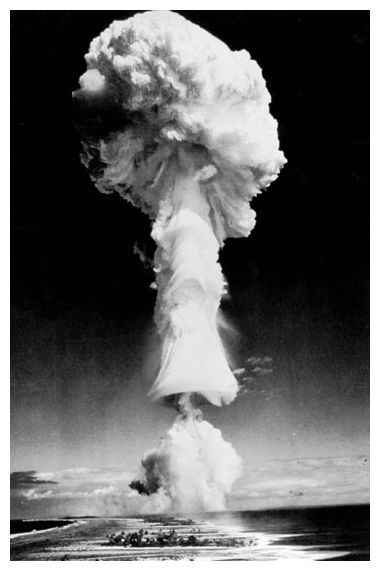
The documents cover the 46 atmospheric nuclear tests conducted at Mururoa and Fangataufa in French Polynesia between 1966 and 1974 and reveal that warships near the tests were hit by higher levels of radioactivity than known.
A New Zealand Labour Government in 1974 sent two warships, HMNZS Canterbury and HMNZS Otago, to monitor the Mururoa tests. It was not believed, at the time, that they may have received nuclear dusting but these new documents reveal there were much higher levels of radiation than were known.
A 1974 test, code named Centaur, dumped 500 times the maximum allowed level of plutonium fallout on Tahiti, 1250 kilometres away, the documents show.
There were also 140 more incidents of nuclear fallout above the 209 incidents already known. Tahiti, home to around 178,000 people, was hit 37 times by fallout.
Radiation levels frequently rose in New Zealand 4700 kilometres away following each test. Opposition to the testing was a key political issue in New Zealand, not only prompting the despatching of warships, but also a successful International Court of Justice case against France.
In 1985 French secret agents sank a Greenpeace ship, Rainbow Warrior, as it was preparing to leave Auckland for Mururoa. One man was killed.
Today in French Polynesia the 47th anniversary of the first nuclear test at Mururoa (a plutonium fission bomb code-named Aldebaran) is being marked.
A local association of nuclear workers, Mururoa e Tatou, released a detailed analysis of 2050 pages in 58 documents of French Military of Defence documents kept secret. Of the new documents, 114 pages were blanked out by the military.
In January, French Overseas Territory Minister Victorin Lurel approved release of the documents to a French Polynesian official investigating the impact of the tests, Bruno Barillot. Before Barillot completed his study, he was fired by the new pro-Paris territorial government of Gaston Flosse.
Mururoa e Tatou head Roland Oldham yesterday released the documents and Barillot's study and, according to the Tahiti Infos news website, the documents show that fallout hit more often and in more places across French Polynesia than was previously released.
These include distant islands, popular with tourists, such as Bora Bora and Hiva Oa.
Oldham told Radio New Zealand International that the documents were a big worry.
"But in Tahiti there is also a fall-out of plutonium 500 times higher than the maximum dose that a human being can have."
It was the right of the Polynesian people to find out what happened.
"And it's also the right for our future generation to know what has happened in this country after 30 years of nuclear tests."
After French ended atmospheric testing, it conducted another 147 underground tests.
The documents show that the explosions have left a residual mass of about 500 kilogrammes of plutonium 239. It is extremely toxic and has to be contained for 240,000 years before it can enter the wider environment.
Source: Fairfax NZ News



Radiation dangers are to easy to cover up. Can't see it, taste it, or smell it. Testing for it requires special equipment. TPTB want nuclear energy to destroy life, not to supply our energy needs. It's good for you, they say, so go back to sleep. The MSM doesn't even mention Fukushima anymore and if they do it is of no immediate danger. Try to find out real information. The alt sites scream red alert. The gov sites say it safe but provide very little real data. Radiation causes cancer, but also weakened immune systems, weakened heart muscle, and of course DNA damage. Uranium mining was the first insult, then add Nuclear testing, Chernobyl, Fukushima that can't be fixed, the Hanford leaks that can't be fixed, and all the other nuclear power plants past their prime. Fukushima is getting worse, not better.
Alt sites:
[Link][Link][Link]
Gov sites:
[Link][Link]
Radiation is lethal to life on this earth. Will there be any to witness the coming comets? Each little release of radiation may be below allowable limits but what is the cumulative dosage doing to life on earth?